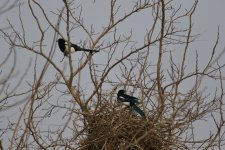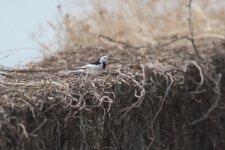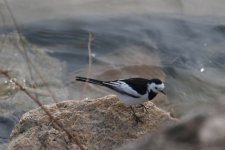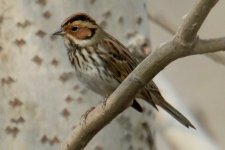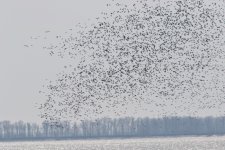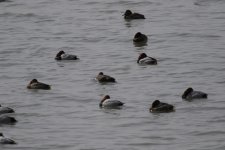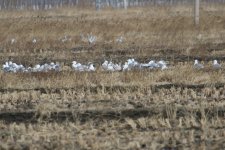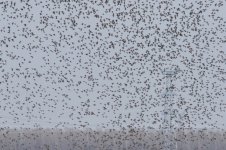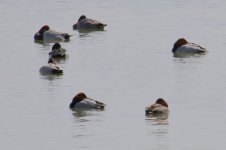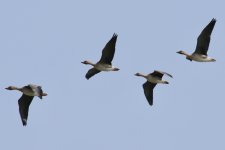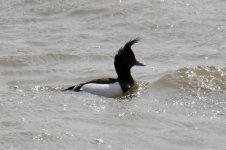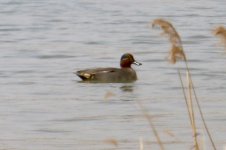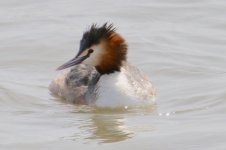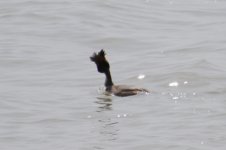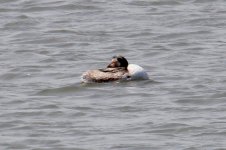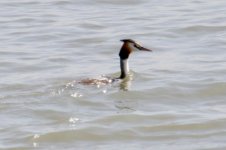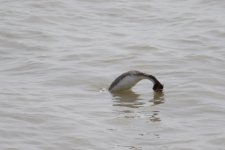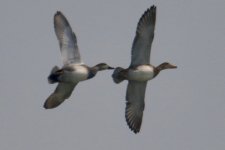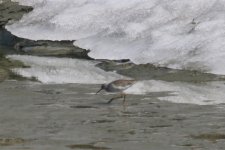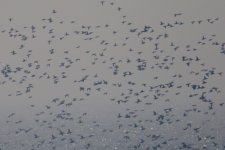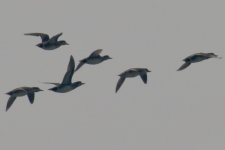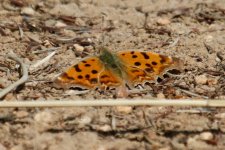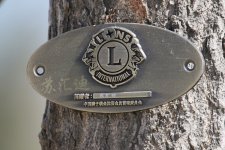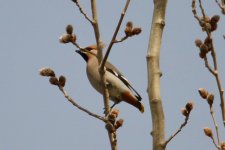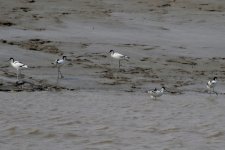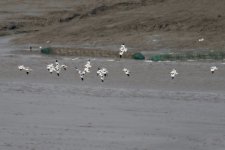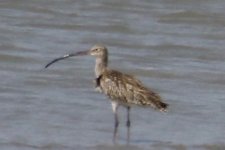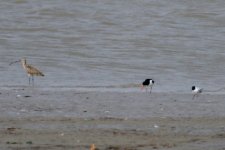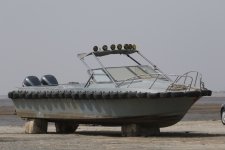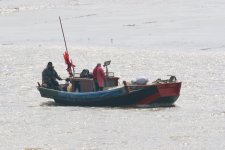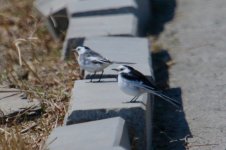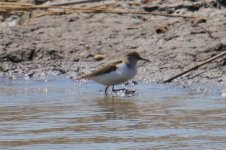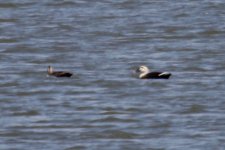-
Welcome to BirdForum, the internet's largest birding community with thousands of members from all over the world. The forums are dedicated to wild birds, birding, binoculars and equipment and all that goes with it.
Please register for an account to take part in the discussions in the forum, post your pictures in the gallery and more.
You are using an out of date browser. It may not display this or other websites correctly.
You should upgrade or use an alternative browser.
You should upgrade or use an alternative browser.
Panjin Birding by the Old Fat Man (3 Viewers)
- Thread starter Owen Krout
- Start date
More options
Who Replied?Owen Krout
Well-known member

Gedalou reservoir MAR-14
Despite the 200+ AQI from the faintly orange colored smog, I decided that the 14°C temperature and almost dead calm was too good to pass up and I made a trip out to the Gedalou reservoir which can vary from nothing to more birds than one can give justice to. The photography conditions were horrible due to the heavy smog and very dim light but still produced two new life list ticks! The lake was mostly clear of ice but still quite low as we have had only a couple of cm of snow this winter.
The life list ticks came in the form of 42 Ruddy Shelduck & a dozen Northern Shovelers. Other than that was the usual gulls which were especially difficult to ID today due to the poor seeing. White against orange grey smog makes it hard to make out detail!
I got a count of 16 Common Magpie with more to be found as the population seems to be exploding. Also in larger numbers than I have seen there in the past were White Wagtail which were all along the rock wall at the edge of the road.
A small flock of Bean Goose flew over and a couple of Little Grebe were making an early appearance. Just as I was walking out seven Grey Heron rose up and circled overhead briefly.
The rest were were just the common actors and one very noisy flock of Tree Sparrow that I estimated at 80 birds.
Gedalou Reservoir, Panjin, Dawa County, Liaoning, CN, Liaoning, CN
Mar 14, 2018 10:30 AM - 1:00 PM
Protocol: Traveling
4.0 kilometer(s)
15 species (+2 other taxa)
Taiga/Tundra Bean-Goose (Anser fabalis/serrirostris) 10
Ruddy Shelduck (Tadorna ferruginea) 42
Northern Shoveler (Spatula clypeata) 12
Eastern Spot-billed Duck (Anas zonorhyncha) 2
Mallard (Anas platyrhynchos) 7
Green-winged Teal (Anas crecca) 8
Little Grebe (Tachybaptus ruficollis) 2
Gray Heron (Ardea cinerea) 7
Black-headed Gull (Chroicocephalus ridibundus) 50
Herring Gull (Larus argentatus) 65
Eurasian Collared-Dove (Streptopelia decaocto) 1
Eurasian Kestrel (Falco tinnunculus) 2
Eurasian Magpie (Pica pica) 16
Dusky/Naumann's Thrush (Turdus eunomus/naumanni) 8
White Wagtail (Motacilla alba) 17
Little Bunting (Emberiza pusilla) 10
Eurasian Tree Sparrow (Passer montanus) 80
View this checklist online at https://ebird.org/view/checklist/S43639211
Despite the 200+ AQI from the faintly orange colored smog, I decided that the 14°C temperature and almost dead calm was too good to pass up and I made a trip out to the Gedalou reservoir which can vary from nothing to more birds than one can give justice to. The photography conditions were horrible due to the heavy smog and very dim light but still produced two new life list ticks! The lake was mostly clear of ice but still quite low as we have had only a couple of cm of snow this winter.
The life list ticks came in the form of 42 Ruddy Shelduck & a dozen Northern Shovelers. Other than that was the usual gulls which were especially difficult to ID today due to the poor seeing. White against orange grey smog makes it hard to make out detail!
I got a count of 16 Common Magpie with more to be found as the population seems to be exploding. Also in larger numbers than I have seen there in the past were White Wagtail which were all along the rock wall at the edge of the road.
A small flock of Bean Goose flew over and a couple of Little Grebe were making an early appearance. Just as I was walking out seven Grey Heron rose up and circled overhead briefly.
The rest were were just the common actors and one very noisy flock of Tree Sparrow that I estimated at 80 birds.
Gedalou Reservoir, Panjin, Dawa County, Liaoning, CN, Liaoning, CN
Mar 14, 2018 10:30 AM - 1:00 PM
Protocol: Traveling
4.0 kilometer(s)
15 species (+2 other taxa)
Taiga/Tundra Bean-Goose (Anser fabalis/serrirostris) 10
Ruddy Shelduck (Tadorna ferruginea) 42
Northern Shoveler (Spatula clypeata) 12
Eastern Spot-billed Duck (Anas zonorhyncha) 2
Mallard (Anas platyrhynchos) 7
Green-winged Teal (Anas crecca) 8
Little Grebe (Tachybaptus ruficollis) 2
Gray Heron (Ardea cinerea) 7
Black-headed Gull (Chroicocephalus ridibundus) 50
Herring Gull (Larus argentatus) 65
Eurasian Collared-Dove (Streptopelia decaocto) 1
Eurasian Kestrel (Falco tinnunculus) 2
Eurasian Magpie (Pica pica) 16
Dusky/Naumann's Thrush (Turdus eunomus/naumanni) 8
White Wagtail (Motacilla alba) 17
Little Bunting (Emberiza pusilla) 10
Eurasian Tree Sparrow (Passer montanus) 80
View this checklist online at https://ebird.org/view/checklist/S43639211
Attachments
Owen Krout
Well-known member

Gedalou reservoir MAR-20
Managed a trip to Gedalou Reservoir today and boy was it worth it!
As the car dropped me off I immediately noticed a few Gadwall in one of the smaller ponds surrounding the reservoir and took time to observe. A nice start. I then walked up the ramp to the level of the reservoir and stopped dead in my tracks to stare in disbelief. The lake surface was crowded with ducks and clouds of new arrivals were coming in from the south!
After regaining my composure I started in working on making some sense of what I was seeing. It turned out that literally thousands of Common Pochard were resting & sleeping on the lake with thousands more continually arriving from the south. e-bird questioned my count of 4500 but if anything I am sure that I probably under-counted! There were probably 25% of them that were too far away for even the 10x bins that I just left out as unidentified even though I believe they were more Pochards and large flocks were still arriving as I left. The numbers were large enough that even a flock of about 40 Bean Goose that came in from the south and descended, obviously intending to land on the lake, decided to move on instead. As they lowered they caused a thousand or more Pochard to take flight and this was too much for them.
Even more smaller flocks filled those of the small outlying ponds that had open water. However a few of the smallest ponds did have small groups of Eurasian Teal & Tufted Duck. Even the usually aggressive Black Headed & Mongolian Gull were in much smaller numbers than normal and confined to standing forlorn looking on the surface of the ice on a few ponds. As I left I discovered that most of the Mongolian Gull had actually been driven off the lake and into the surrounding reed fields.
The one new arrival since last week that was managing to keep their shoreline territories clear of Pochard were the Great Crested Grebe which were being very territorial.
A tense moment occurred when a pair of PLA Air Force fighters did a very low pass directly over the lake. Fortunately the clouds of ducks that were stirred up didn't reach the height of the planes until after they passed by.
Gedalou Reservoir, Panjin, Dawa County, Liaoning, CN, Liaoning, CN
Mar 20, 2018 11:00 AM - 1:30 PM
Protocol: Traveling
5.0 kilometer(s)
11 species (+1 other taxa)
Taiga/Tundra Bean-Goose (Anser fabalis/serrirostris) 40
Gadwall (Mareca strepera) 8
Green-winged Teal (Anas crecca) 5
Common Pochard (Aythya ferina) 4500 Several very large flocks covering the main reservoir as well as several smaller flocks on adjacent ponds. Not an overcount. Flights were still arriving as I left. I was able to verify ID using 10x binoculars.
Tufted Duck (Aythya fuligula) 4
Great Crested Grebe (Podiceps cristatus) 25
Eurasian Coot (Fulica atra) 40
Black-headed Gull (Chroicocephalus ridibundus) 65
Herring Gull (Larus argentatus) 105
Eurasian Magpie (Pica pica) 8
White Wagtail (Motacilla alba) 14
Eurasian Tree Sparrow (Passer montanus) 10
Managed a trip to Gedalou Reservoir today and boy was it worth it!
As the car dropped me off I immediately noticed a few Gadwall in one of the smaller ponds surrounding the reservoir and took time to observe. A nice start. I then walked up the ramp to the level of the reservoir and stopped dead in my tracks to stare in disbelief. The lake surface was crowded with ducks and clouds of new arrivals were coming in from the south!
After regaining my composure I started in working on making some sense of what I was seeing. It turned out that literally thousands of Common Pochard were resting & sleeping on the lake with thousands more continually arriving from the south. e-bird questioned my count of 4500 but if anything I am sure that I probably under-counted! There were probably 25% of them that were too far away for even the 10x bins that I just left out as unidentified even though I believe they were more Pochards and large flocks were still arriving as I left. The numbers were large enough that even a flock of about 40 Bean Goose that came in from the south and descended, obviously intending to land on the lake, decided to move on instead. As they lowered they caused a thousand or more Pochard to take flight and this was too much for them.
Even more smaller flocks filled those of the small outlying ponds that had open water. However a few of the smallest ponds did have small groups of Eurasian Teal & Tufted Duck. Even the usually aggressive Black Headed & Mongolian Gull were in much smaller numbers than normal and confined to standing forlorn looking on the surface of the ice on a few ponds. As I left I discovered that most of the Mongolian Gull had actually been driven off the lake and into the surrounding reed fields.
The one new arrival since last week that was managing to keep their shoreline territories clear of Pochard were the Great Crested Grebe which were being very territorial.
A tense moment occurred when a pair of PLA Air Force fighters did a very low pass directly over the lake. Fortunately the clouds of ducks that were stirred up didn't reach the height of the planes until after they passed by.
Gedalou Reservoir, Panjin, Dawa County, Liaoning, CN, Liaoning, CN
Mar 20, 2018 11:00 AM - 1:30 PM
Protocol: Traveling
5.0 kilometer(s)
11 species (+1 other taxa)
Taiga/Tundra Bean-Goose (Anser fabalis/serrirostris) 40
Gadwall (Mareca strepera) 8
Green-winged Teal (Anas crecca) 5
Common Pochard (Aythya ferina) 4500 Several very large flocks covering the main reservoir as well as several smaller flocks on adjacent ponds. Not an overcount. Flights were still arriving as I left. I was able to verify ID using 10x binoculars.
Tufted Duck (Aythya fuligula) 4
Great Crested Grebe (Podiceps cristatus) 25
Eurasian Coot (Fulica atra) 40
Black-headed Gull (Chroicocephalus ridibundus) 65
Herring Gull (Larus argentatus) 105
Eurasian Magpie (Pica pica) 8
White Wagtail (Motacilla alba) 14
Eurasian Tree Sparrow (Passer montanus) 10
Attachments
Owen Krout
Well-known member

Owen Krout
Well-known member

Hi, Tom. It was very windy and as a result he was having a bad "hair" day  Even the Great Crested Grebe were having the same difficulties at times. Speaking of which, here are a few shots of them. At one point I spotted what I first took to be trash floating on the lake but with the telephoto lens proved to be sleeping GCG.
Even the Great Crested Grebe were having the same difficulties at times. Speaking of which, here are a few shots of them. At one point I spotted what I first took to be trash floating on the lake but with the telephoto lens proved to be sleeping GCG.
I am sure that I also had a major undercount on the Grebe, Common Coot and things like the Tufted Ducks as they sit so low in the water or are in small numbers mixed in with the larger flocks or in small groups on the adjacent ponds. With all the action on the main lake, I may easily have missed some of the action on the small ponds. The Common Coot tend to hang out in small groups on the edge of the Pochard flocks.
I am sure that I also had a major undercount on the Grebe, Common Coot and things like the Tufted Ducks as they sit so low in the water or are in small numbers mixed in with the larger flocks or in small groups on the adjacent ponds. With all the action on the main lake, I may easily have missed some of the action on the small ponds. The Common Coot tend to hang out in small groups on the edge of the Pochard flocks.
Attachments
thirudevaram
Trapped in mist ***s
That's plenty of action in your turf, Owen. Interesting to see the gulls in the field, i believe its either harvested Paddy or reeds. I have seen them roosting mostly in dried out ponds.
Owen Krout
Well-known member

Correct, Dev. The foreground is harvested rice and the behind that is harvested reeds. Had a brief talk with an elderly local fellow that same day when we walked by where he was cutting reeds. They were for a cooking fire. That is China - We were delivered in a Cadillac to spend the day bird watching and between camera, lens and binoculars, I was probably carrying several years of income for him around my neck - Yet he was as cheerful and friendly as could be. Even offered to give us a lift back to the highway with his three wheeled put-put for free. The reeds as an abundant local resource actually have a number of common uses here.
Owen Krout
Well-known member

Gedalou reservoir MAR-24
Despite a heavy haze of pollution I decided to try Gedalou Reservoir again today with mixed results. There was actually more variety evident but with frustration to go with it.
The haze was thick enough that visual sightings were only possible under about 250-300 meters, so just finding the flocks out on the lake was somewhat problematic. Fortunately I had decided to try out my new adjustable polarizing filter. It was amazing just how well it did work. Even when nothing was in sight on the lake I found I could scan the water with the filter attached and be able to see where the birds were. Unfortunately that was mostly square in the middle of the lake just out of the range of being able to identify any further than "Duck". The haze washing out color and the greenish-gray tint of the filter where not helping IDs either. I'll include a shot of part of the flock of at least 1000 "Duck" that couldn't be seen at all without the polarizing filter in place.
I did come up with Gadwall that were doing a courtship ritual with pairs flying up in tight formation then back down to the water. Pochard & Mallards would also occasionally have small flights break off from the mass in the middle and fly out close enough to be identified in the binoculars. Fortunately the binoculars also did a good job of cutting through the haze to spot birds that were totally hidden to the naked eye. One small flock of Common Coot let the wind drive them close enough to the shore to ID. Meanwhile a few Great Crested Grebe continued to stake out their territories along the lake shore.
Culling through photos after I got home I did find a small group of Falcated Duck with the long "falcated" feathers drooping over the stern giving a good confirmation of ID despite the poor lighting. Also I had caught a flight of Baikal Teal whose distinctive facial markings can be seen in the original photo. I'm not sure how well you will be able to see it in the JPG here, but will include it.
Just as we were leaving I did find some Common Redshank on one of the small ponds. Oddly the adjacent pond had some exposed mud that would seem to have been better for foraging, but they were intent on poking at the ice sheet. I don't know what they could have been finding there.
Gedalou Reservoir, Panjin, Dawa County, Liaoning, CN, Liaoning, CN
Mar 24, 2018 11:30 AM - 1:15 PM
Protocol: Traveling
4.0 kilometer(s)
12 species
Baikal Teal (Sibirionetta formosa) 6
Gadwall (Mareca strepera) 26
Falcated Duck (Mareca falcata) 4
Mallard (Anas platyrhynchos) 7
Common Pochard (Aythya ferina) 18
Eurasian Coot (Fulica atra) 20
Common Redshank (Tringa totanus) 24
Black-headed Gull (Chroicocephalus ridibundus) 15
Herring Gull (Larus argentatus) 30
Eurasian Magpie (Pica pica) 8
Little Bunting (Emberiza pusilla) 15
Eurasian Tree Sparrow (Passer montanus) 10
View this checklist online at https://ebird.org/view/checklist/S43905754
Despite a heavy haze of pollution I decided to try Gedalou Reservoir again today with mixed results. There was actually more variety evident but with frustration to go with it.
The haze was thick enough that visual sightings were only possible under about 250-300 meters, so just finding the flocks out on the lake was somewhat problematic. Fortunately I had decided to try out my new adjustable polarizing filter. It was amazing just how well it did work. Even when nothing was in sight on the lake I found I could scan the water with the filter attached and be able to see where the birds were. Unfortunately that was mostly square in the middle of the lake just out of the range of being able to identify any further than "Duck". The haze washing out color and the greenish-gray tint of the filter where not helping IDs either. I'll include a shot of part of the flock of at least 1000 "Duck" that couldn't be seen at all without the polarizing filter in place.
I did come up with Gadwall that were doing a courtship ritual with pairs flying up in tight formation then back down to the water. Pochard & Mallards would also occasionally have small flights break off from the mass in the middle and fly out close enough to be identified in the binoculars. Fortunately the binoculars also did a good job of cutting through the haze to spot birds that were totally hidden to the naked eye. One small flock of Common Coot let the wind drive them close enough to the shore to ID. Meanwhile a few Great Crested Grebe continued to stake out their territories along the lake shore.
Culling through photos after I got home I did find a small group of Falcated Duck with the long "falcated" feathers drooping over the stern giving a good confirmation of ID despite the poor lighting. Also I had caught a flight of Baikal Teal whose distinctive facial markings can be seen in the original photo. I'm not sure how well you will be able to see it in the JPG here, but will include it.
Just as we were leaving I did find some Common Redshank on one of the small ponds. Oddly the adjacent pond had some exposed mud that would seem to have been better for foraging, but they were intent on poking at the ice sheet. I don't know what they could have been finding there.
Gedalou Reservoir, Panjin, Dawa County, Liaoning, CN, Liaoning, CN
Mar 24, 2018 11:30 AM - 1:15 PM
Protocol: Traveling
4.0 kilometer(s)
12 species
Baikal Teal (Sibirionetta formosa) 6
Gadwall (Mareca strepera) 26
Falcated Duck (Mareca falcata) 4
Mallard (Anas platyrhynchos) 7
Common Pochard (Aythya ferina) 18
Eurasian Coot (Fulica atra) 20
Common Redshank (Tringa totanus) 24
Black-headed Gull (Chroicocephalus ridibundus) 15
Herring Gull (Larus argentatus) 30
Eurasian Magpie (Pica pica) 8
Little Bunting (Emberiza pusilla) 15
Eurasian Tree Sparrow (Passer montanus) 10
View this checklist online at https://ebird.org/view/checklist/S43905754
Attachments
Last edited:
thirudevaram
Trapped in mist ***s
Well, Well, Well....That many Baikal Teals...don't be humble Owen, this a time to drum up.
MKinHK
Mike Kilburn

Sounds like a magnificent spectacle - and totally with Dev's comments about the Baikal Teals - very special birds! Very heartening to hear about so many Pochard - they are certainly pretty rare these days in Hong Kong.
The geese in your photo are Tundra Bean Geese - which have heavier heads and shorter necks than Taiga.
Cheers
Mike
The geese in your photo are Tundra Bean Geese - which have heavier heads and shorter necks than Taiga.
Cheers
Mike
Owen Krout
Well-known member

Thanks Dev. The BTeal where a lucky find as it was just a quick shot I took when the movement caught my eye as the V flew from behind to my left. Apparently from one of the small fish ponds and it looked like they probably went all the way across the lake. I would guess to a fish pond on the other side. Almost missed the confirmation photo as the camera struggled to focus and when it did I was surprised and thinking, "Those look like Biakal Teal!?" Fortunately, I remembered to push the shutter button despite my excitement.
Yea, I was being lazy Mike. We get so many of both here that unless I get both on the same day I often just write down "Bean Goose" in my field notes. Not uncommon at Gedalou to have both Taiga and Tundra in two flocks side by side.
We get so many of both here that unless I get both on the same day I often just write down "Bean Goose" in my field notes. Not uncommon at Gedalou to have both Taiga and Tundra in two flocks side by side.
Yea, I was being lazy Mike.
Owen Krout
Well-known member

A trip to Dawa's East Lake Park which is appropriately enough on the east edge of Dawa City was mostly a bust for the Passerines that can be found there. Just a little too early in the season and this is the park that looked like it had been the target of a heavy artillery barrage last summer, which will probably contribute to fewer numbers this year. Still found a few interesting things while there though.
First of all it does look a lot better now. The old functional standard concrete pavement on the walkways was replaced with more artistic stone and stone embedded in concrete and a lot of landscaping was done to make it more artistically pleasing. In addition, in a rare occurrence for China, the park was actually expanded again. My wife says that when she visited the area in the late '80's there was only the lake and I have seen the park expanded significantly twice now in the last five years. In the long run will make for more excellent Passerine habitat.
While there I noted my first butterfly of the season with a single Comma. Also we noticed 50 or more Ginko bilboba trees planted during the improvements that had little brass plaques attached. Curious and looking closer I was surprised to see they were a Lion's Club project. My wife said the plaque indicated a Shenyang Club. My own ignorance, but I didn't realize it was such a large international organization.
Also, deciding what to discard or keep from the last week, I found a photo I had forgotten about with my wife next to a rather odd artistic piece made from woven reeds. Closer to home a local collecting reeds within 500 meters of our home. Finally, the only birds of note in the last few days where some Bohemian Waxwing.
First of all it does look a lot better now. The old functional standard concrete pavement on the walkways was replaced with more artistic stone and stone embedded in concrete and a lot of landscaping was done to make it more artistically pleasing. In addition, in a rare occurrence for China, the park was actually expanded again. My wife says that when she visited the area in the late '80's there was only the lake and I have seen the park expanded significantly twice now in the last five years. In the long run will make for more excellent Passerine habitat.
While there I noted my first butterfly of the season with a single Comma. Also we noticed 50 or more Ginko bilboba trees planted during the improvements that had little brass plaques attached. Curious and looking closer I was surprised to see they were a Lion's Club project. My wife said the plaque indicated a Shenyang Club. My own ignorance, but I didn't realize it was such a large international organization.
Also, deciding what to discard or keep from the last week, I found a photo I had forgotten about with my wife next to a rather odd artistic piece made from woven reeds. Closer to home a local collecting reeds within 500 meters of our home. Finally, the only birds of note in the last few days where some Bohemian Waxwing.
Attachments
Owen Krout
Well-known member

No camera today on a short walk with the dog but one notable in that I did manage to pick out one Japanese Waxwing mixed in with 8 or more Bohemian Waxwing. I had another flock of what I am almost certain was Waxwing go over but higher than the 30 story building they disappeared behind, so I was not able to ID for sure.
Speaking of which I think I had a Yellow-breasted Bunting in the bushes, but it was very shy and just as I was trying to be certain with the binoculars from a safe distance I jumped as someone put their hand on my arm. Turned out they were nice enough to tell me that my "little dog was leaving". Apparently she got tired of me starting at a stupid bird and decided to head for home on her own. Of course having the worst sense of direction of any dog I have ever owned she was headed in the wrong direction. By the time I tracked her down and came back there was no sign of the bunting. Was still very tempted to claim it as it would be another Life tick.
Speaking of which I think I had a Yellow-breasted Bunting in the bushes, but it was very shy and just as I was trying to be certain with the binoculars from a safe distance I jumped as someone put their hand on my arm. Turned out they were nice enough to tell me that my "little dog was leaving". Apparently she got tired of me starting at a stupid bird and decided to head for home on her own. Of course having the worst sense of direction of any dog I have ever owned she was headed in the wrong direction. By the time I tracked her down and came back there was no sign of the bunting. Was still very tempted to claim it as it would be another Life tick.
Owen Krout
Well-known member

April 1, 2018
I was busy this Easter Sunday finding out where I couldn't bird. After much lamenting and tearing of the hair by the family 8-P in response to my wanting to go an unbelievable 30 kilometers, or even more, to check out the only local area with recent sightings recorded of cranes, I rented a taxi today and set out. The target was the area variously called the Shuangtaizi Estuary Waterfowl Nature Preserve or the more common local name of Liaoheckou Nature Preserve. A large area along both banks, confusingly enough, of the Shuangtaizi He, not the Liaohe. This is the area where the Snowy Owl was reported late last year. IBA Code CN052
I had been told late last year that it had been designated a closed area to travel and sure enough when we arrived at the north gate along the west bank I was curtly and definitively denied entry. I was willing to pay an entry fee but was told to leave immediately. I decided to try the east bank and it actually looked better with the road immediate to the river but once again, "Bu yo", and the hand wave to go away.
OK, that didn't work so I decided to try a large reservoir just inland of the Red Beach Tourist Area. That failed when that road was closed also. At this point the driver was getting noticeably nervous, probably worried that this crazy foreigner was going to get him in trouble.
Therefore I decided to give him an easy one and paid another 100RMB to go to Erjiguo, a village on the banks of the estuary at the south gate of the Red Beach area. We arrived there to find that in the last two years there has been extensive use of dredged silt from the estuary to in fill the marsh around the village and my viewing sight is now no longer on the bank of the river. I did however find a spot right by the south gate of Red Beach where I did find a few waterfowl. The 37 Pied Avocet were enough to be challenged by ebird, but I did have photos! There were also a few of both Black-headed Gull & Saunder's Gull. A few Far Eastern Curlew were spotted at distance and one lone Oystercatcher.
Being convinced that the driver was going to kill me at any moment with his need for speed and wild driving style and being relatively close to a potential area at the Liao River estuary where the map showed a park along the river between Dawa County and Yingkou, I asked to go near there and let him go while I hiked into the area. Being low tide, I figured on some mud flats to attract waders. Turns out there has been a lot of development in that area too and after wandering around and never getting to the river I gave up and walked back to the bus stop where I could head back home. Looking at it now on the map I think the river was actually only about 200 meters to the east of where I gave up. Oh well, try again later.
Going to speak to our contacts and see if there is anyway to get permission to go into the areas where I was denied today.
I was busy this Easter Sunday finding out where I couldn't bird. After much lamenting and tearing of the hair by the family 8-P in response to my wanting to go an unbelievable 30 kilometers, or even more, to check out the only local area with recent sightings recorded of cranes, I rented a taxi today and set out. The target was the area variously called the Shuangtaizi Estuary Waterfowl Nature Preserve or the more common local name of Liaoheckou Nature Preserve. A large area along both banks, confusingly enough, of the Shuangtaizi He, not the Liaohe. This is the area where the Snowy Owl was reported late last year. IBA Code CN052
I had been told late last year that it had been designated a closed area to travel and sure enough when we arrived at the north gate along the west bank I was curtly and definitively denied entry. I was willing to pay an entry fee but was told to leave immediately. I decided to try the east bank and it actually looked better with the road immediate to the river but once again, "Bu yo", and the hand wave to go away.
OK, that didn't work so I decided to try a large reservoir just inland of the Red Beach Tourist Area. That failed when that road was closed also. At this point the driver was getting noticeably nervous, probably worried that this crazy foreigner was going to get him in trouble.
Therefore I decided to give him an easy one and paid another 100RMB to go to Erjiguo, a village on the banks of the estuary at the south gate of the Red Beach area. We arrived there to find that in the last two years there has been extensive use of dredged silt from the estuary to in fill the marsh around the village and my viewing sight is now no longer on the bank of the river. I did however find a spot right by the south gate of Red Beach where I did find a few waterfowl. The 37 Pied Avocet were enough to be challenged by ebird, but I did have photos! There were also a few of both Black-headed Gull & Saunder's Gull. A few Far Eastern Curlew were spotted at distance and one lone Oystercatcher.
Being convinced that the driver was going to kill me at any moment with his need for speed and wild driving style and being relatively close to a potential area at the Liao River estuary where the map showed a park along the river between Dawa County and Yingkou, I asked to go near there and let him go while I hiked into the area. Being low tide, I figured on some mud flats to attract waders. Turns out there has been a lot of development in that area too and after wandering around and never getting to the river I gave up and walked back to the bus stop where I could head back home. Looking at it now on the map I think the river was actually only about 200 meters to the east of where I gave up. Oh well, try again later.
Going to speak to our contacts and see if there is anyway to get permission to go into the areas where I was denied today.
Attachments
Owen,
It is a petty you needed to do so much effort and still could not reach your goal of spotting cranes. Although my family is agreeing to arrange the trip to the Huanzidong Reservoir near Shenyang, we still don’t have any real plans. It is quite a challenge without a car. If we go, I am also afraid that we will waste time in finding the correct locations for viewing birds on the lake, similar to what you experienced. We didn’t find much information regarding access to the place.
At least you had a good find with the Pied Avocet. The range in Brazil's book doesn't cover Liaoning. Any idea how common it was during Tom Beeke’s time in Dalian? Something about it in his book?
Bart
It is a petty you needed to do so much effort and still could not reach your goal of spotting cranes. Although my family is agreeing to arrange the trip to the Huanzidong Reservoir near Shenyang, we still don’t have any real plans. It is quite a challenge without a car. If we go, I am also afraid that we will waste time in finding the correct locations for viewing birds on the lake, similar to what you experienced. We didn’t find much information regarding access to the place.
At least you had a good find with the Pied Avocet. The range in Brazil's book doesn't cover Liaoning. Any idea how common it was during Tom Beeke’s time in Dalian? Something about it in his book?
Bart
Last edited:
Owen Krout
Well-known member

Bart,
I did find a China Daily article from last year at the end of March which sounds encouraging. http://www.chinadaily.com.cn/m/liaoning/investinshenyang/2017-03/23/content_28655889.htm "Every spring and autumn, it welcomes around 3,000 rare birds, including about 2,000 white cranes, which land to recharge their batteries for between 90 and 100 days."
There are still some good birding areas around. The frustrating part is finding them and gaining access. As in the USA, China is becoming so urbanized that most of the people that I have contact with are genuine city slickers who are abhorred by the idea of actually setting foot off the pavement. Hence most also have no interest or actual knowledge of any areas of interest to me as I am delighted to follow a dirt path into the woods. When the former vice-mayor of Dawa inquired about how to attract foreigners for birding, I suggested that they needed to have pre-vetted locals available as guides to the best viewing areas and that villagers would probably be the best fit as they had more direct contact with nature. Wouldn't be expensive to provide some basic training to four of five people, give them a title, call them Rangers or something that sounds good in Chinese and let them earn some money on the side charging a preset fee to any interested birders. It didn't go over well. Putting foreigners in direct contact with lowly villagers? That's crazy talk!
I have had another idea, which my wife is highly resistant to, which is to provide boat tours up and down the Shuangtaizi and Liao Rivers or even the bigger reservoirs. Most of the really good birding tends to be along the banks anyway and might be a way around the access restrictions. Even was thinking about that on my last outing. A moderate sized flat bottom boat might give better stability for viewing and photography and we wouldn't be interested in speed anyway. A slow quiet drift that doesn't spook everything would actually be better. Looks like an older couple Mom and Pop fishing operation here that might be delighted to make some easy money ferrying crazy foreigners up and down the river.
The Pied Avocet were indeed a nice find. Brazil says they winter along the Chinese coast and they breed well north of here, so it is logical that they may stop over on migration. Tom's book has them as "unusual" in Dalian and to be found on coastal mudflats during migration, which is exactly where they were.
I did find a China Daily article from last year at the end of March which sounds encouraging. http://www.chinadaily.com.cn/m/liaoning/investinshenyang/2017-03/23/content_28655889.htm "Every spring and autumn, it welcomes around 3,000 rare birds, including about 2,000 white cranes, which land to recharge their batteries for between 90 and 100 days."
There are still some good birding areas around. The frustrating part is finding them and gaining access. As in the USA, China is becoming so urbanized that most of the people that I have contact with are genuine city slickers who are abhorred by the idea of actually setting foot off the pavement. Hence most also have no interest or actual knowledge of any areas of interest to me as I am delighted to follow a dirt path into the woods. When the former vice-mayor of Dawa inquired about how to attract foreigners for birding, I suggested that they needed to have pre-vetted locals available as guides to the best viewing areas and that villagers would probably be the best fit as they had more direct contact with nature. Wouldn't be expensive to provide some basic training to four of five people, give them a title, call them Rangers or something that sounds good in Chinese and let them earn some money on the side charging a preset fee to any interested birders. It didn't go over well. Putting foreigners in direct contact with lowly villagers? That's crazy talk!
I have had another idea, which my wife is highly resistant to, which is to provide boat tours up and down the Shuangtaizi and Liao Rivers or even the bigger reservoirs. Most of the really good birding tends to be along the banks anyway and might be a way around the access restrictions. Even was thinking about that on my last outing. A moderate sized flat bottom boat might give better stability for viewing and photography and we wouldn't be interested in speed anyway. A slow quiet drift that doesn't spook everything would actually be better. Looks like an older couple Mom and Pop fishing operation here that might be delighted to make some easy money ferrying crazy foreigners up and down the river.
The Pied Avocet were indeed a nice find. Brazil says they winter along the Chinese coast and they breed well north of here, so it is logical that they may stop over on migration. Tom's book has them as "unusual" in Dalian and to be found on coastal mudflats during migration, which is exactly where they were.
Attachments
Owen Krout
Well-known member

A quick post today as the last few days have been cold and mixed drizzle and snow.
I ran across an interesting article from ebird's All About Birds newsletter. Quoting: "But the tide might now be turning for shorebirds, as the Chinese government announced in January that it will halt business-oriented coastal land reclamation “in the strictest-ever control over reclamation,” according to China’s State Oceanic Administration." article: https://www.allaboutbirds.org/chine...il&utm_term=0_47588b5758-7aa240b74f-309534497
Given the importance of conservation of tidal mud flats to migrating shorebirds in particular, I was wondering if anyone else has any relevant observations or discussion. It is of particular interest to me as Panjin itself is mostly built on infilled land from dredging of the Bohai Gulf.
I ran across an interesting article from ebird's All About Birds newsletter. Quoting: "But the tide might now be turning for shorebirds, as the Chinese government announced in January that it will halt business-oriented coastal land reclamation “in the strictest-ever control over reclamation,” according to China’s State Oceanic Administration." article: https://www.allaboutbirds.org/chine...il&utm_term=0_47588b5758-7aa240b74f-309534497
Given the importance of conservation of tidal mud flats to migrating shorebirds in particular, I was wondering if anyone else has any relevant observations or discussion. It is of particular interest to me as Panjin itself is mostly built on infilled land from dredging of the Bohai Gulf.
Owen Krout
Well-known member

April 8, 2018
Yesterday was a remarkably fine day, even with little wind, which is unusual here this time of year. I decided to take advantage and took the 1.5 hour bus ride down to the mouth of the DaLiao River at Yingkou and the Yingkou Wetlands Park.
I made for the wetlands first where numbers can and do range from little to uncountable numbers of shorebirds. The tide was well out by the time I arrived and hence wide expanses of mud flats were exposed. However, they were almost devoid of any birds with the exception of a few Common Sandpiper and a small flock of Black-headed Gull resting in a single flock. The surrounding wetlands were not crowded either but did yield enough to be of interest and make for an enjoyable day.
As soon as I entered the wetland area I was greeted by five White Wagtail which were courting with short hop flights straight up and back down to the same place. Turning my attention to the small ponds I was quickly rewarded with a couple of Little Egret. It was only after cropping a photo after getting home that I saw there was also a Common Redshank standing right next to the Little Egret I was fixated on. I did notice the Common Sandpiper standing nearby though. A couple of Eurasian Teal flew off as I approached closer to verify for sure that I was looking at LE not Intermediate E.
Most of the other ponds were empty, but one yielded 77 Pochard floating out in the middle and four Eastern Spot-Billed Duck. Two of the Spot Billed were more muted in coloration, matching with what I normally see here. The other two, however, flashed so bright white that my initial sighting was at such a distance that I at first only saw the white heads which looked very small and thought I was possibly seeing some Smew. I finally managed to work my way around to where I could get a reasonable photo and look with the bins. Sure enough, a very clean, bright white and much bigger than I first thought.
About 75 Eurasian Tree Sparrow and a couple of Common Magpie, that were picking through where the tourist trap nearby dumps its garbage into the wetland, were the only other sightings other than a single Eurasian Kestrel.
EDIT: That is indeed a Black-winged Stilt, not a Redshank. I didn't get a photo of the Redshank.
Yingkou Wetland Park, Liaoning, CN
Apr 8, 2018 12:00 PM - 2:00 PM
Protocol: Traveling
3.0 kilometer(s)
11 species
Eastern Spot-billed Duck (Anas zonorhyncha) 6
Green-winged Teal (Anas crecca) 3
Common Pochard (Aythya ferina) 77
Little Egret (Egretta garzetta) 6
Common Sandpiper (Actitis hypoleucos) 6
Common Redshank (Tringa totanus) 1
Black-headed Gull (Chroicocephalus ridibundus) 30
Eurasian Kestrel (Falco tinnunculus) 1
Eurasian Magpie (Pica pica) 2
White Wagtail (Motacilla alba) 5
Eurasian Tree Sparrow (Passer montanus) 75
View this checklist online at https://ebird.org/view/checklist/S44379778
This report was generated automatically by eBird v3 (http://ebird.org)
Yesterday was a remarkably fine day, even with little wind, which is unusual here this time of year. I decided to take advantage and took the 1.5 hour bus ride down to the mouth of the DaLiao River at Yingkou and the Yingkou Wetlands Park.
I made for the wetlands first where numbers can and do range from little to uncountable numbers of shorebirds. The tide was well out by the time I arrived and hence wide expanses of mud flats were exposed. However, they were almost devoid of any birds with the exception of a few Common Sandpiper and a small flock of Black-headed Gull resting in a single flock. The surrounding wetlands were not crowded either but did yield enough to be of interest and make for an enjoyable day.
As soon as I entered the wetland area I was greeted by five White Wagtail which were courting with short hop flights straight up and back down to the same place. Turning my attention to the small ponds I was quickly rewarded with a couple of Little Egret. It was only after cropping a photo after getting home that I saw there was also a Common Redshank standing right next to the Little Egret I was fixated on. I did notice the Common Sandpiper standing nearby though. A couple of Eurasian Teal flew off as I approached closer to verify for sure that I was looking at LE not Intermediate E.
Most of the other ponds were empty, but one yielded 77 Pochard floating out in the middle and four Eastern Spot-Billed Duck. Two of the Spot Billed were more muted in coloration, matching with what I normally see here. The other two, however, flashed so bright white that my initial sighting was at such a distance that I at first only saw the white heads which looked very small and thought I was possibly seeing some Smew. I finally managed to work my way around to where I could get a reasonable photo and look with the bins. Sure enough, a very clean, bright white and much bigger than I first thought.
About 75 Eurasian Tree Sparrow and a couple of Common Magpie, that were picking through where the tourist trap nearby dumps its garbage into the wetland, were the only other sightings other than a single Eurasian Kestrel.
EDIT: That is indeed a Black-winged Stilt, not a Redshank. I didn't get a photo of the Redshank.
Yingkou Wetland Park, Liaoning, CN
Apr 8, 2018 12:00 PM - 2:00 PM
Protocol: Traveling
3.0 kilometer(s)
11 species
Eastern Spot-billed Duck (Anas zonorhyncha) 6
Green-winged Teal (Anas crecca) 3
Common Pochard (Aythya ferina) 77
Little Egret (Egretta garzetta) 6
Common Sandpiper (Actitis hypoleucos) 6
Common Redshank (Tringa totanus) 1
Black-headed Gull (Chroicocephalus ridibundus) 30
Eurasian Kestrel (Falco tinnunculus) 1
Eurasian Magpie (Pica pica) 2
White Wagtail (Motacilla alba) 5
Eurasian Tree Sparrow (Passer montanus) 75
View this checklist online at https://ebird.org/view/checklist/S44379778
This report was generated automatically by eBird v3 (http://ebird.org)
Attachments
Last edited:
Similar threads
Users who are viewing this thread
Total: 4 (members: 0, guests: 4)




